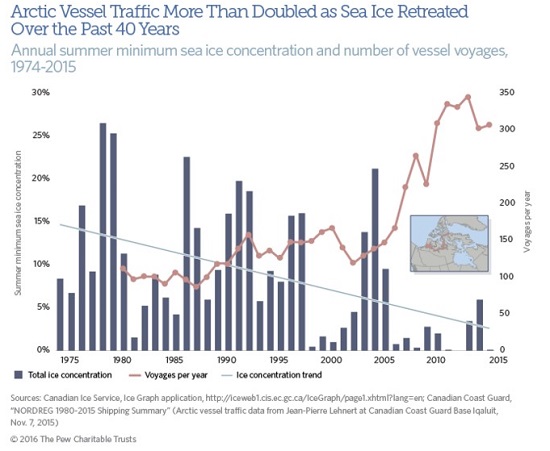The melting Arctic ice caused by climate change is opening up vast areas is Canada’s north to commercial and tourist shipping, A new report recommends that Inuit leaderships and communities be consulted in crafting a cohesive Arctic shipping policy that would ensure the safety of complex marine environments, critical habitat areas and humans.
An analysis by the Pew Charitable Trusts of the shipping patterns in the Canadian Arctic Ocean shows an increase by as much as 166 per cent in sea vessel traffic through the Canadian Northwest Passage since 2004. The release of the report yesterday comes in the wake of reports that come August this year, a 259-metre luxury liner, the Crystal Serenity will take some 1,700 tourists on a week-long voyage through the passage which Norwegian polar explorer Roald Amundsen and his companions charted the area during a three-year expedition back in 1906.
This is the first time that the region and its inhabitants will see such an influx of people, and the Crystal Serenity tour will likely be not the last. As commercial and tourist traffic increase, the movement of people and machine could have a drastic impact on the existing marine life and local communities, according to the Pew Charitable Trusts report.
“Government, industry, and Inuit organizations agree that Canada’s Arctic shipping policy need to advance to meet these challenges,” the report said. “The Canadian government’s existing management of Arctic shipping does not sufficiently account for the environmental and social complexity of the region. For decades, government departments, academics, and civil society groups have made recommendations for reform. However, Canada still lacks a clear, cohesive vision for Arctic shipping policy.”
In 2012, the Canadian Coast Guard began to address some of the deficiencies in the nation’s Arctic shipping policy by launching the Northern Marine Transportation Corridors Initiative (NMTCI).
That initiative, the report said, seeks to establish a system of voluntary marine corridors toward which the Coast Guard and other agencies could direct their financial, material, and human resource capacity to support vessel safety in the Arctic.
“The NMTCI could be the foundation for a national Arctic shipping policy, but for this to happen, it must be expanded to adequately account for the environmental and social complexity of Canada’s the Arctic Ocean,” according to the report. “The Integrated Arctic Corridors Framework builds on the NMTCI to help Canada improve human and vessel safety in Arctic waters, empower Inuit organizations to ensure that Arctic shipping enhances instead of threatens their long-term well-being, reduce risks to the environment, and give mariners the guidance and tools to travel the safest possible routes.”
The report’s key recommendations include the following:
- Create a governance structure for Arctic shipping corridor development and management.
- Consult and meaningfully engage Inuit leadership and communities.
- Integrate information including shipping and ice data, wildlife migration routes, and human use, including Inuit traditional knowledge.
- Designate voluntary shipping corridors that meet appropriate environmental standards for commercial shipping in ecologically and biologically sensitive areas.
- Classify shipping corridors according to risk to ensure targeted investment in infrastructure and services and management of high-risk areas.
These would entail the creation of a permanent management structure co-chaired by Inuit and governments that would oversee, support and monitor safe marine traffic within the corridor.
The operations would require icebreakers capable of patrolling the frigid expanses of the Northwest Passage. However, according to the Shipping Federation of Canada, the country’s Coast Guard is badly in need of renewing its existing fleet of polar icebreakers.
“The current plan to rely on the construction of a single polar class icebreaker, which was commissioned by the previous government at a cost of over $1 billion for delivery in 2022 at the earliest, is not a viable solution,” the federation said.



